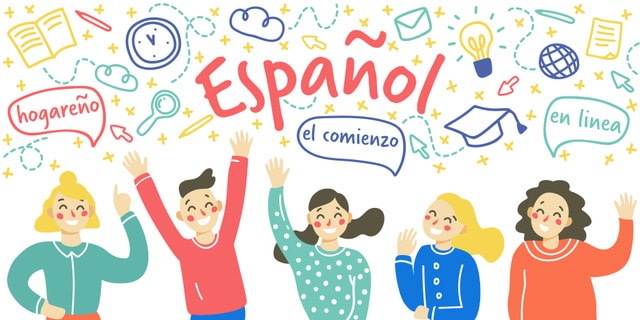Spanish is the third most spoken language in the world. There are 350 million native speakers and 70 million people speak it as their second language.
If you took high school Spanish or did it as a course in college, you probably aren’t a part of those numbers. Besides the valid criticism of formal lessons, Spanish wasn’t easy for most of us.
You’re not alone! Most of us have some of the same challenges in learning Spanish. These are the hardest parts about learning Spanish, for you and probably everyone else.
Can you relate to these challenges in learning Spanish?
1. Conjugations
Simply put, a conjugation is basically the various forms of a verb that gives information about the subject. Spanish conjugations will also give you information about the time as well as the mood.
Usually, when you’re first learning Spanish, at least in a classroom, you learn the personal pronouns and how to conjugate regular verbs in the present tense. It makes Spanish seem easy enough.
Next, you start learning about irregular verbs in the present tense. Before you know it, you’re learning about the past tense, the imperfect tense, the present perfect tense, and now you’re overwhelmed.
It can be difficult to memorize the conjugations in all the various tenses for both regular and irregular verbs as well as memorizing the verb itself.
Flashcards and spending hours studying probably didn’t work in high school to make you fluent and it’s still not ideal now. Noting conjugations while watching shows and listening to dialogue can help you learn it much more quickly and effectively.
2. Double “R” Sound
If you had tried to learn Spanish in a formal setting, were you both amazed and jealous of the students who could roll their Rs perfectly?
You are definitely not the only English speaker who gets anxious seeing the “rr” in a word or any word that begins with ‘R’ for that matter. You know it is supposed to give you a rolled R sound, but for some reason, it’s not working when you do it.
If it makes you feel any better, some Spanish speakers have struggled with making the sound. Think about little kids even learning English; that R often sounds like a W for many years!
The answer to your problem is going to sound so cliche that you might roll your eyes but the best thing to do is practice practice practice. It’s basically muscle memory, so keep doing it!
3. Dropping the Subject
Remember when I said the conjugation of the verb gives you information about the subject?
The information is so accurate that sometimes Spanish speakers just drop the subject because the verb already tells them all they need to know.
For example, instead of saying Yo hablo ingles which means “I speak English”, the Yo might be dropped and the person says Hablo ingles. It works because hablo is the first person conjugation in the present tense of the verb hablar”(to speak) and it literally means “I speak”.
If you also use the subject yo, you could actually sound like you’re emphasizing yourself, since yo is not needed. You’ll be a haughty American: I speak English. Hmph!
It might take a while to get used to since we typically don’t drop the pronoun or subject in English. The more you listen to the dialogue with native speakers, the more commonplace it will seem. You’ll be automatically doing it in no time.
4. Deciding Which Country’s Vocabulary/Slang/Accent to Study
You might have heard about the difference between American English and British English. We don’t typically say ‘trousers’ and the British don’t typically say ‘pants’.
The same way we have our own unique vocabulary, slangs and accents is quite the same in Spanish. For example, bus in Argentina is colectivo but it’s autobús in Barcelona, Spain.
The accents can be vastly different as well. Even though you’re fluent in Spanish from Mexico, you could be lost when a native speaker from Argentina tries to have a conversation with you.
This can definitely pose a challenge. That’s why it’s important to decide which country’s Spanish you want to learn. The choice may be made for you if you plan to visit somewhere specific quite soon and often, but if you’re pretty flexible, then you can always watch shows or listen to a podcast from the various countries so you know which one you want to study.
If you have made up your mind already, the podcast and shows would also be helpful so that you can become accustomed to the accent, the various vocabulary words unique to each region, and their slang.
Don’t forget to listen for their expressions/full phrases and not just individual words as these vary from country to country as well.
5. Expressions
After taking the time to learn your verbs, you were probably left confused when you found out that ser and estar both meant “to be” but they can’t be used interchangeably.
Things start to get really overwhelming when you have to use tener the verb to say something that you would have used the verb “to be” for in English.
For example: instead of saying Yo soy/estoy veinticinco años (“I am 25 years old”) you say, Yo tengo veinticinco años which directly translates to “I have 25 years”.
The quicker you accept that English and Spanish just aren’t the same language and have these nuances, the better it will be for you. Just learn the expressions and try not to do so much direct translation; it may throw you off and simply slow you down.
Don’t analyze. Just talk!
Spanish can be difficult to learn but it’s not impossible. There are ways you can learn it without sitting in a classroom.
However, the only solution to these challenges and to get fluent is to practice. If you’re ready to become fluent and you’d like to learn more about TruFluency’s online fluency coaches, check out our Spanish teachers and their availability.
Get started today with 2 hours of trial classes for only $39!





